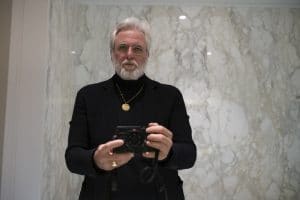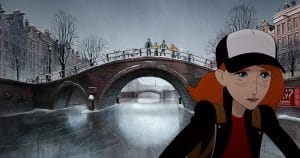The Kaboom animation festival opened Wednesday in Amsterdam with a film that, having premiered at Cannes last year, had been looked forward to for a while. Where is Anne Frank, an international production (with a Dutch part too) by Israeli filmmaker Ari Folman. An animated film that takes Anne Frank's famous diary to a new level.
It is a year in the future. In the first scene, a bleak wind chases across Amsterdam's canal, where a chilly line of tourists waits for the door of the Anne Frank House to open. Inside, something miraculous happens at that moment. A display case bursts open and from the ink of the famous diary rises the figure of Kitty. Anne's imaginary friend is suddenly no longer imaginary. She grabs the book, begins a search through Amsterdam for Anne, and befriends Awa, a young refugee from Africa. At the same time, this creative and imaginative animation also looks back to the past, where scenes from the world of Anne and her family in hiding come to life.
Director Ari Folman, who became famous with Walz With Bashir, should have been at the opening of Kaboom himself, but a positive coronary test put a damper on his trip to Amsterdam. Fortunately, he is feeling well enough for zoom interviews from his home near Tel Aviv. That way I can still speak to him.

I am curious when he first read Anne Frank's diary.
"I was 14, it was compulsory material at school in Israel. I know that, but I don't really remember it. I grew up in a family of Holocaust survivors. When I was young, I heard so much about the terrible concentration camps. Anne Frank was one of many stories and her last months, in the camps, do not appear in the diary either. They do in the film."
For young audiences
The Anne Frank Fund asked you to make this film?
"Yes indeed, they approached me, but I turned it down at first because I thought everything was already done. But as the father of a teenager, I started reading the book again, and I was amazed at how well it was written. By a girl of 13! Unbelievable. So then I started playing with the thought of doing it anyway. And how to do it."
Did it have to be an animated film?
"Yes, I set a few conditions. First of all, it had to be an animated film for children from around 10 years old. In doing so, it had to include Anne Frank's last seven months. That end of Anne was initially also in the last act of The Diary of Anne Frank, the 1959 film, but when Otto Frank saw at a test screening how shocked the audience was by the footage of Bergen-Belsen, he asked the producers to remove it."
"But I thought it was important. And finally the connection between past and present. To do justice to Otto Frank's legacy and to the Anne Frank Fund, we need to use this story to create compassion and empathy for children in war zones around the world."
Just a word about that animation, I think after Walz With Bashir and The Congress had let it be known that he no longer wanted to make animated films. What made you change your mind?
Laughing: "You know, I'm not going to say that anymore. I might think it, but I won't say it out loud anymore."
"I think I'm addicted to animation. To the amazing creative aspects of it, because you can make anything that comes to your imagination, and maybe also to the insane difficulties of making an animated film."
Imagination

But why animation in this case?
"To reach a young audience. To make sure the subject appeals to them. Very important."
I tell him that I think it will also appeal to adults. To which Folman asks me if I think the film will do well in the Netherlands. Hard to say, but I expect it will. In any case, the distributor has already booked many school screenings.
But then about the set-up of the film, are there any other sides to it aimed at young audiences?
"It has the structure of a fairy tale," Folman explains. "Already in the first scene, something magical happens. From the ink of the diary, Kitty miraculously comes to life. It's classic children's film material. For example, there are all kinds of rules, such as that Kitty is invisible to visitors in the Anne Frank House. Only Anne can see her imaginary friend. And the diary is Kitty's heart. If it gets too far away she disappears again."
She cannot exist without the diary.

"And then there is Kitty as Anne's alter-ego. She is everything Anne can't be at the time, both in appearance and in the things she does."
Is it also kind of a tribute to Anne's imagination?
"Definitely. Look, one of my goals was to give real meaning to the icon, the symbol that Anne became. Anne Frank was a dream character for a screenwriter. She was wise, smart, but also funny and sometimes very mean, very human, with her own problems and issues, classic teenage stuff with her mother and with boys falling in love with her. We need to tear down that statue that Anne Frank has become to make her real, to open the hearts of everyone who sees her on the movie screen."
Hollywood and Greek mythology
A coming-of-age story, in other words.
"It's mainly a coming-of-age story. It's set during the Holocaust, but it's about the friendship between two girls in a coming-of-age drama."
Without too many spoilers, can you say anything about the last part of the film where you show the camp as a world from Greek mythology?
"As I said, I was looking for a way to show Anne's last seven months. I couldn't show it as it really was, because I don't believe that's possible. Not in an animated film, nor in a feature film. I don't believe it's possible."
"So I was looking for a way to crack that problem. Anne Frank has two passions. Hollywood actors from the 1930s and 1940s, and Greek mythology. And when you see the underworld from Greek mythology, it has a lot in common with the Nazis' methods. Here the trains taking the Jews to the concentration camps, there the ferries. Selections here, selections there. Dogs here, dogs there. So while on the soundtrack we hear someone reading out the words from Otto Frank's book, we see that Greek underworld."
It might even make the story more universal.
"I think so, a more accessible story too."
Refugee
And you link it to the situation of refugees. Were you not afraid of criticism of a possible comparison of the Holocaust with contemporary refugees?
Stern: "There is no comparison at all, because there simply cannot be. I expected more criticism, frankly. But refugees in Amsterdam, that has nothing to do with concentration camps. I don't see any possible comparison here."
No, but I assume there was a reason for including this refugee story in the film.
"Someone told me after a screening: 'The Jews no longer had the privilege of being refugees, they were massacred.' So I don't think there is a comparison. Just as there is no sensible way to compare the genocide of one people with the genocide of another."
"But I do think that a child in a war zone is a child in a war zone, that is a hard fact. There is no difference between a child whose house has been bombed in Ukraine and a child in Mali who has no idea who attacked his village. Both have to flee. One with mother to the border, the other north to eventually cross the Mediterranean. No difference!"
Otto Frank
But what was the reason for adding this theme?
"Otto Frank's legacy was for a reason. By ensuring that 70 million copies of her diary were sold, he fulfilled a dream of his daughter. He donated all that money - he continued to live in a 1-bedroom flat all his life - to non-profit organisations helping children in war zones. For that, he set up the Fund that approached me for the film. As I firmly believe in their objective, I felt it was important to convey their message. Creating compassion, tolerance and empathy, to support the children, that is a respectable goal of the film. Even if I have to work for it for eight years."
Because that's how long production lasted.
With some self-mockery: "Now for a ninth year of talking about the film!"
Education
I also understand that the film is part of a wider project, with two comic books and an educational offering.
"Yes, that's all there. Anne Frank's Diary (The rear house) as a comic book was a way to convince distributors that we could make a film. The second comic book (Where is Anne Frank) is a by-product of the film, based on the screenplay. The first, released in 2018, is the original diary in comic book form."
"The educational material produced by the Fund is a book for teachers and pupils. The latter learn the story of Anne Frank, the history of Jews in the Netherlands during the war, and how this relates to contemporary crises. I think the Fund did a fantastic job, and it is being made available to schools free of charge. In addition, you can still see the film, wonderful."
Have you experienced any performances with young audiences? How were the reactions?
"These were the best screenings I have attended, even better than the beautiful premiere in Cannes. Children of about 10 to 12 years old completely understand the film, they are fantastic. They react very genuinely and emotionally. A tear flows when Kitty arrives at the sisters' grave in Bergen-Belsen."
The film is set a year in the future, so are you a bit of an SF enthusiast?
"I am mainly Sci-Fi fan! As for the rest, there are only details..."
Following the festival comes Where is Anne Frank from 7 April in cinemas. The comic book based on the film Where is Anne Frank's diary by Ari Folman and Lena Guberman is published by publisher Prometheus and was released on 9 March. In collaboration with Eye Educatie, Cinéart will release the teaching package for Dutch schools, available from around mid-April.
